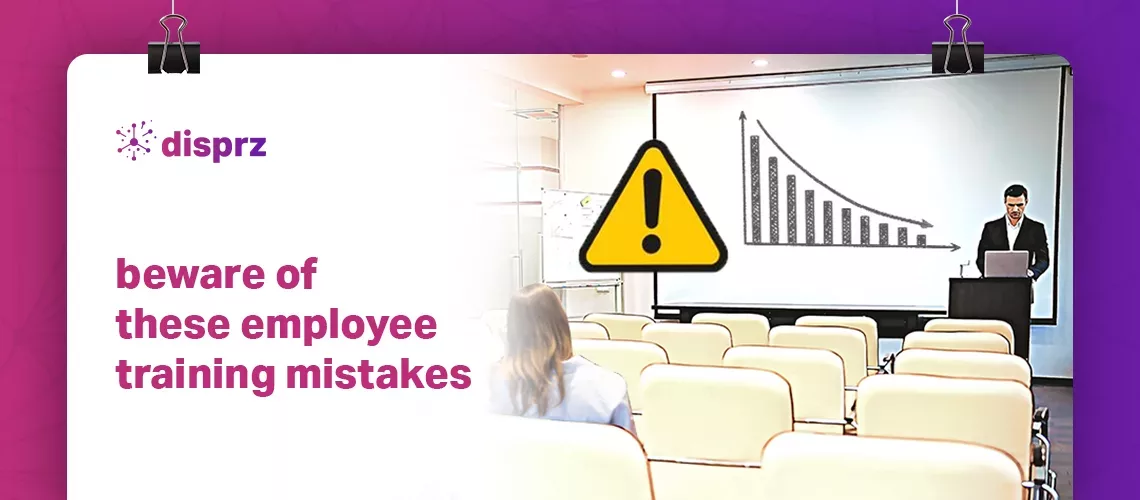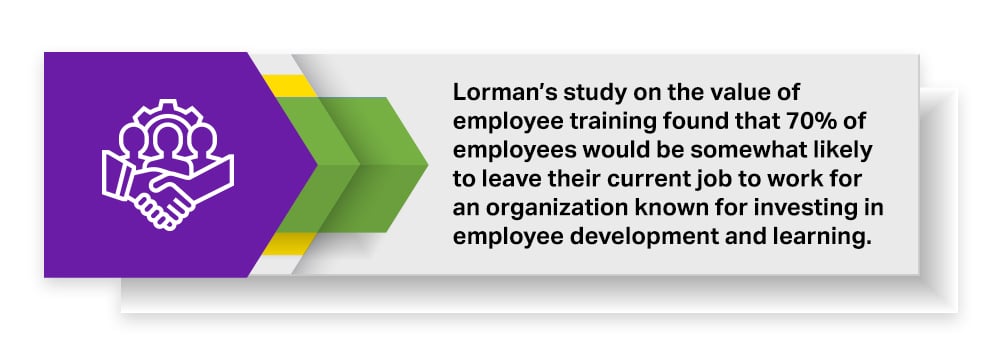
6 min read
• 17 Apr 2024
Employee Training and Development Mistakes to Avoid in 2024
Discover the top 5 employee training and development mistakes that you should avoid when running an L&D program in 2024.
-
eBookEmployee Upskilling - A Detailed Blueprint For Building A Skills-Driven Learning Culture
Employees are the most valuable assets for any company. That’s why it is imperative to help them focus on their growth by offering continuous learning opportunities. Robust employee training and development is more important now than ever, especially as companies fight to retain their top talent.
With movements like the Great Resignation and Quitting , Employee Career Cushioning has become the latest workplace trend. With the mass layoff and economic headwinds, employees are ready with a plan B. They are keeping their options open and exploring new opportunities for job security.
Lorman’s study on the value of employee training found that 70% of employees would be likely to leave their current job to work for an organization known for investing in employee development and learning.

To retain your employees, you must win their trust. You must give them the right workplace learning opportunities to promote career progression and internal mobility within your organization. The best way to achieve this is by having a solid employee development plan. However, you must be extra careful while creating and implementing the plan. Making any employee training and development mistakes during the process can lead to disappointing outcomes.
Employee Training and Development Mistakes That Jeopardize Your L&D ROI
Whether you are trying to improve your employees’ strengths or bridge the knowledge and skills gap, your efforts will be futile without an effective employee training and development plan.
If you are looking to achieve the best results from your employee development programs, here are a few mistakes you must avoid in 2024.
1. Failure to align employee L&D with business goals
L&D professionals who create employee training programs without visibility of the business goals, do not often see success. They generally neglect the wider business objectives, therefore failing to make employees active contributors to driving the organization’s business outcomes.
Once the end goals are clear, it becomes easier to pin down the employee skills, capabilities and competencies needed to achieve them in real-time.
2. Neglecting experiential learning
Are employees putting into action the knowledge they absorb through learning and development? Unfortunately, the practical component of L&D is often overlooked while designing and delivering employee training and development programs. Avoid making the mistake of neglecting experiential learning, as it aids in providing immersive learning experiences.
The Chinese proverb “I hear, and I forget, I see, and I remember, I do, and I understand” aptly applies to modern employees with short attention spans. On paper, an L&D strategy might seem perfect, but employees often face difficulties while applying them to real-life scenarios. That’s why it is crucial to give hands-on experience and nurture meaningful employee development by enabling employees to practice what they learn.
3. Creating a “one-size-fits-all” approach to employee development
If generic content was impactful, more than 70% of employees would have already gained the necessary skills they needed to achieve their career goals. Sadly, that’s not the case. It is important to embrace personalization by making learning relevant to each employee to ensure individual skill gaps are filled.
Personalized learning breaks through the clutter and filters content that’s in line with each learner’s unique requirements for career advancement. Enabling personalized learning ensures strong employee engagement and aids in building necessary competencies by giving dedicated attention to each employee’s improvement areas.
4. A lack of focus on learning engagement
Employees are less likely to learn if your development programs are not engaging. Unfortunately, most L&D professionals stick to lengthy learning theories that fail to capture learner attention. This typically leads to the employee leaving the course modules unfinished and ultimately not completing the employee training and development program.
L&D professionals need to shift their focus to increase learning engagement. Adding Gamification elements like quizzes and a roulette wheel can make online learning sessions interactive and more lively. Moreover, badges and leaderboards help in striking healthy competition and make employees more enthusiastic about improving their standing in the development program.
5. Not including employee reskilling and cross-skilling for internal mobility
One of the biggest employee development mistakes is not including reskilling and cross-skilling to drive career growth. At times, L&D professionals focus on ticking their training checklist rather than unlocking the employee’s full potential. Promoting lateral and vertical internal mobility through cross-skilling and reskilling elevates not only employee training and development but also boosts employee retention. That’s why you must expand your skilling initiatives and give employees the opportunity to learn new skills and take on new responsibilities within their role.
Leverage The Right Learning Technology To Avoid These Employee Training and Development Mistakes
Modern learning technologies are well-equipped with features that can level up employee development and training. L&D technology, like a Learning Experience Platform (LXP), is a one-stop solution for creating a meaningful learning journey for the overall development of the employee. By leveraging an LXP, L&D professionals can easily plan the entire employee training and development process and avoid the mistakes mentioned above. An innovative LXP that is powered with AI can bring added advantages as it aids in:
- Precise skill assessment – Through vivid subjective and objective assessment helps pinpoint gaps and guide the employee training and development plan
- Advanced content curation- The powerful content curation capabilities enable you to create learning journeys that are aligned with the organization’s goals.
- Smart AI-based recommendation – Makes employee development personalized by recommending relevant content based on benchmarked skills and the organization’s priority.
- Seamless talent mobility – Encourage employees to develop the right skills and grow within the company by providing visibility into lateral and vertical career paths
- Intuitive employee training impact – With detailed reports and analytics, determine if the employee training and development programs are succeeding in driving business impact.
See a preview to find out how Disprz LXP can help in elevating employee training and development.
About the author

Debashree Patnaik
Debashree is a seasoned content strategist at Disprz.ai, specializing in enterprise learning and skilling. With diverse experience in B2B and B2C sectors, including ed tech, she leads the creation of our Purple papers, driving thought leadership. Her focus on generative AI, skilling, and learning reflects her commitment to innovation. With over 6 years of content management expertise, Debashree holds a degree in Aeronautical Engineering and seamlessly combines technical knowledge with compelling storytelling to inspire change and drive engagement.
More Resources
4 min read
• 15 Apr 2024
Unlocking the Power of Managerial Engagement in Talent Development
4 min read
• 09 Apr 2024
Nurturing Excellence in Building Leadership Pipelines
Sign up to get free resources and stay up to date with Disprz!
Discover how Disprz can align learning and upskilling with your desired business outcomes.





